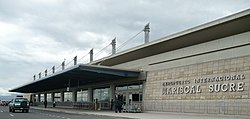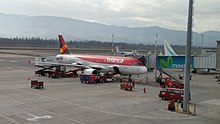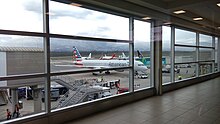avia.wikisort.org - Aerodrome
Mariscal Sucre International Airport[3] (Spanish: Aeropuerto Internacional Mariscal Sucre) (IATA: UIO, ICAO: SEQM) is an international airport serving Quito, Ecuador. It is the busiest airport in Ecuador and one of the busiest airports in South America. It is located in the Tababela parish, about 18 kilometres (11 mi)[4] east of Quito and serves as the largest hub for Avianca Ecuador and LATAM Ecuador. It also served as the main hub for TAME, Ecuador's flag-carrier, before the airline was liquidated by the Ecuadorian government in 2020.[5] The airport opened in February 2013 and replaced the 53-year old airport of the same name.[6] The airport is named after independence leader Antonio José de Sucre. It is rated as the only 5-star airport in the Western Hemisphere by Skytrax.[7][8]
Mariscal Sucre International Airport Aeropuerto Internacional Mariscal Sucre | |||||||||||
|---|---|---|---|---|---|---|---|---|---|---|---|
 | |||||||||||
| |||||||||||
| Summary | |||||||||||
| Airport type | Public | ||||||||||
| Operator | Quiport,[1] CORPAQ[2] | ||||||||||
| Serves | Quito | ||||||||||
| Location | Tababela, Quito Canton, Pichincha | ||||||||||
| Opened | 20 February 2013 | ||||||||||
| Hub for | |||||||||||
| Elevation AMSL | 2,400 m / 7,874 ft | ||||||||||
| Coordinates | 0°06′48″S 78°21′31″W | ||||||||||
| Website | www www | ||||||||||
| Map | |||||||||||
 UIO Location of airport in Ecuador | |||||||||||
| Runways | |||||||||||
| |||||||||||
Location
The new Quito International Airport is located on the Oyambaro plain near the town of Tababela, about 18 kilometers (11 mi) east of Quito, Ecuador. The location was chosen in order to expand the capacity of the city's airport.
The old airport posed enormous risks because it was located in the middle of a mountainous city with high wind currents. It could no longer be expanded to accommodate larger aircraft or increased air traffic, and had been the scene of numerous incidents and accidents during the latter years of its operation.[9][10]
History









Construction began in 2006.[11] A re-negotiation of the financing contract for the airport was signed on 9 August 2010.[12]
At about 6:19 a.m. on July 2, 2012, an American Airlines Boeing 757 landed at the new airport with about 100 passengers on board. The flight was used to obtain the operating certificate for track tests. It also allowed testing of the performance of the electronics mounted for handling and transporting luggage and check-in counters for passengers and baggage. The aircraft departed from the existing Mariscal Sucre International Airport with Quito's Mayor, Augusto Barrera, local authorities, aviation staff, and the media to pre-test[clarification needed] boarding procedures at 5:30 a.m., later taking off at about 6:10 a.m. After a 9-minute flight, the flight landed at the new Airport. After landing and subsequent taxiing through taxiway 1 of the new airport, the airplane was greeted with a water cannon salute from two fire trucks.
Subsequently, visitors toured the facilities of the passenger terminal building and the north and south ends of the runway. After the tour, Mayor Barrera and authorities gave a press conference. There, the Mayor also stated that the airport would be ready at its inauguration, as well as enhancements to the E-35, and Interoceanic highways. "This is a day of joy and optimism for the city. At this point all you get joining goodwill," the official said adding that the social energy that the city should serve to build and make things.[citation needed]
Mayor Barrera also stated that this airport will be a remarkable leap in economic development of the city of Quito and that the strategic alliance with Quiport achieved with the resources generated by the new airport will be for all the people of Quito. "We are checking with the facts that transformation we're doing for the Quito we crave" he said. The mayor also reported that when the Mariscal Sucre Airport closes, construction of a new park will begin at the current site, and within days the bidding will begin for the 1st phase of the planned Quito Metro, as well as for the construction of a new bridge over the Chiche river.[citation needed]
The official inauguration was postponed from October, 2012, citing the progress of improvements to various access routes, the holiday season, and other factors. The new airport commenced operations on 20 February 2013 following the closure of the old airport the night before. The first flights scheduled to arrive at the new airport were TAME flight 302 from Guayaquil (domestic), and LAN flight 2590 from Lima, Peru (international). Arrival times were scheduled for 9:00 and 9:30 a.m. respectively.[13]
Airlines and destinations

Passenger
| Airlines | Destinations |
|---|---|
| Aeroméxico | Mexico City |
| Aeroregional | Coca, Loja, Machala Charter: Caracas, Lima, Panama City–Balboa, Porlamar, Punta Cana, Valencia (VE) |
| Air Europa | Madrid1 |
| American Airlines | Miami |
| Arajet | Santo Domingo–Las Américas[14] |
| Avianca | Bogotá |
| Avianca Costa Rica | Buenos Aires–Ezeiza,[15] San José de Costa Rica–Juan Santamaría |
| Avianca Ecuador | Baltra, Bogotá, Cuenca, Guayaquil, Manta |
| Avianca El Salvador | San Salvador |
| Avioandes | Charter: Esmeraldas, Macas |
| Conviasa | Caracas |
| Copa Airlines | Panama City–Tocumen |
| Delta Air Lines | Atlanta |
| Equair | Baltra, Guayaquil, San Cristóbal |
| Iberia | Madrid |
| JetBlue | Fort Lauderdale |
| KLM | Amsterdam2 |
| LATAM Ecuador | Bogotá, Coca, Cuenca, Guayaquil, Loja, Manta, Miami, San Cristóbal |
| LATAM Perú | Lima |
| United Airlines | Houston–Intercontinental |
| Wingo | Bogotá |
Notes:
- 1: Air Europa's flight from Quito to Madrid makes a stop in Guayaquil.
- 2: KLM's flight from Quito to Amsterdam makes a stop in Guayaquil.
Cargo
This section does not cite any sources. (August 2021) |
| Airlines | Destinations |
|---|---|
| Air Canada Cargo | Montréal–Trudeau,[16] Toronto-Pearson[17] |
| Avianca Cargo | Bogotá, Medellín–JMC, Miami |
| Cargolux | Bogotá, Luxembourg |
| DHL Ecuador | Guayaquil |
| Emirates SkyCargo | Aguadilla |
| Ethiopian Airlines Cargo | Addis Ababa, Bogotá, Miami |
| FedEx Express | Memphis |
| LATAM Cargo Chile | Santiago de Chile |
| Martinair | Amsterdam |
| Qatar Airways Cargo | Doha, Liège, Miami |
| UPS Airlines | Miami |
Statistics
Annual traffic
| Year | Total passengers | Cargo (TM) |
|---|---|---|
| 2001 | 400,900 | |
| 2002 | 577,800 | 9,990.10 |
| 2003 | 609,900 | 10,000.80 |
| 2004 | 795,600 | 21,590.55 |
| 2005 | 825,300 | 26,556.20 |
| 2006 | 955,500 | 30,010.50 |
| 2007 | 1,771,859 | 35,256.40 |
| 2008 | 2,569,800 | 40,123.65 |
| 2009 | 3,000,560 | 40,996.60 |
| 2010 | 4,026,521 | 50,023.65 |
| 2011 | 5,000,500 | 70,785.09 |
| 2012 | 5,120,000 | 164,412.03 |
| 2013 | 5,421,106 | 215,036.88 |
| 2014 | 5,574,019 | 300,090.90 |
| 2015 | 5,376,544 | 301,400.10 |
| 2016 | 4,852,530 | 303,460.90 |
| 2017 | 4,875,166 | 312,112.90 |
| 2018 | 5,158,103 | - |
| 2019 | 5,037,650 | - |
| 2020 | 1,500,290 | - |
Top destinations
| Rank | Change | City | Passengers | % Change | Top carriers |
|---|---|---|---|---|---|
| 1 | 103.710 | Copa Airlines | |||
| 2 | 92.107 | Avianca, Avianca Ecuador, Wingo | |||
| 3 | 85.815 | Air Europa, Iberia, Plus Ultra Líneas Aéreas | |||
| 4 | 81.952 | American Airlines | |||
| 5 | 53.609 | Avianca Ecuador, LATAM Ecuador | |||
| 6 | 53.410 | Aeroméxico, Interjet | |||
| 7 | 42.897 | United Airlines | |||
| 8 | 33.243 | KLM | |||
| 9 | 32.166 | JetBlue Airways | |||
| 10 | 28.250 | Delta Air Lines | |||
| 11 | 15.805 | LATAM Chile | |||
| 12 | 15.215 | American Airlines | |||
| 13 | 14.779 | Air Canada Rouge | |||
| 14 | 12.439 | Air France | |||
| 15 | 10.851 | Avianca El Salvador | |||
| 16 | 7.381 | Gol Transportes Aéreos |
| Rank | Change | City | Passengers | % Change | Top carriers |
|---|---|---|---|---|---|
| 1 | 411.923 | Aeroregional, Avianca Ecuador, LATAM Ecuador, TAME | |||
| 2 | 113.817 | Aeroregional, LATAM Ecuador, TAME | |||
| 3 | 74.295 | Avianca Ecuador, LATAM Ecuador, TAME | |||
| 4 | 42.532 | Avianca Ecuador, LATAM Ecuador, TAME | |||
| 5 | 41.188 | Aeroregional, TAME | |||
| 6 | 33.703 | Avianca Ecuador, LATAM Ecuador, TAME | |||
| 7 | 22.219 | Avianca Ecuador, LATAM Ecuador, TAME | |||
| 8 | 9.143 | TAME | |||
| 9 | 6.502 | TAME | |||
| 10 | 4.527 | TAME |
See also
- Transport in Ecuador
- List of airports in Ecuador
References
- "Aeropuerto Mariscal Sucre - Home". Archived from the original on June 7, 2015. Retrieved June 6, 2015.
- Empresa Publica Metropolitana de Servicios Aeroportuarios Archived December 1, 2009, at the Wayback Machine
- "Se develó la placa con el nombre del aeropuerto de Quito". Archived from the original on December 16, 2013. Retrieved June 6, 2015.
- "Un nouvel aéroport international pour Quito" [A new international airport for Quito] (in French). Air Journal. February 22, 2013. Archived from the original on February 26, 2013.
- TAME (February 17, 2021). "Communication to our suppliers". Retrieved February 17, 2021.
- "New Quito Airport officially inaugurated by Ecuadorean President; operational from 09:00 20-Feb-2013". Centre for Aviation. February 21, 2013. Archived from the original on August 21, 2014.
- Skytrax (May 11, 2020). "Quito Mariscal Sucre International Airport is Certified with the 5-Star Regional Airport Rating". Retrieved May 11, 2020.
- Skytrax (May 11, 2020). "Quito International Airport reaches the premier category in the world". Retrieved May 11, 2020.
- Report Archived 2007-09-29 at the Wayback Machine on the conditions of the current airport and the benefits of a new airport (Inter-American Development Bank)
- "ASN Aircraft accident Tupolev 154M CU-T1264 Quito-Mariscal Sucre Airport (UIO)". Aviation Safety Network. Flight Safety Foundation. November 13, 2005. Archived from the original on February 20, 2009. Retrieved April 8, 2009.
- Pereira Lima, Edvaldo (February 25, 2013). "Ecuador's new Quito airport opens". Air Transport World. Archived from the original on February 27, 2013.
- "Ecuador Officially Signs New Quito Airport Finance Deal". Wall Street Journal. August 10, 2010. Retrieved August 11, 2010.
- "Tababela se inaugurará con 129 vuelos". Archived from the original on February 22, 2013. Retrieved February 19, 2013.
- "Arajet inicia la venta de dos nuevos destinos internacionales". August 28, 2022.
- "Avianca confirma 4 vuelos semanales entre Quito y Buenos Aires". Nicolas Larenas. Retrieved August 25, 2022.
- "Air Canada Cargo - Widebody Schedule". Retrieved October 17, 2020.
- "Air Canada announces routes for expanded cargo capacity". June 14, 2021.
- "https://www.ecuadorencifras.gob.ec/transporte/"
External links
- New Quito International Airport: Main Information. Quiport Corporation. Retrieved April 12, 2009.
- New Airport: A Door to Development. Corpaq - Quito Airport Corporation. Retrieved April 12, 2009.
- Paco Moncayo Gallegos, ed. (2008). El nuevo aeropuerto de Quito, documentos para la historia (PDF) (in Spanish). Quito, Ecuador: Alcaldía Metropolitana. Archived from the original (PDF) on November 12, 2008.
- Wikivoyage: Tababela
На других языках
[de] Flughafen Quito
Der Aeropuerto Internacional Mariscal Sucre[1] ist ein am 20. Februar 2013 eröffneter[2] internationaler Verkehrsflughafen nahe der ecuadorianischen Hauptstadt Quito. Er ersetzte den bisherigen gleichnamigen kommunalen Flughafen von 1960, der aufgrund seiner zentralen Stadtlage als schwierig zu beherrschen und nicht erweiterbar galt.- [en] Mariscal Sucre International Airport
[es] Aeropuerto Internacional Mariscal Sucre
El Aeropuerto Internacional Mariscal Sucre (IATA: UIO, OACI: SEQM), también llamado Aeropuerto de Tababela, es el aeropuerto internacional de la ciudad de Quito, el de mayor movimiento de pasajeros en general en Ecuador y el segundo del país en tráfico internacional,[1] nombrado oficialmente en honor al militar venezolano Antonio José de Sucre, héroe de la independencia ecuatoriana e hispanoamericana. Está ubicado en una planicie en los suburbios orientales de la ciudad de Quito, en la localidad de Tababela, a 25 km del centro histórico de la urbe.[fr] Aéroport international Mariscal Sucre
L'Aéroport international Mariscal Sucre (code IATA : UIO • code OACI : SEQM), souvent appelé aéroport de Tababela, est l'aéroport international qui dessert la ville de Quito en Équateur depuis le 19 février 2013, date à laquelle il a remplacé l'ancien aéroport international de la ville[1]. Contrairement à l'ancien aéroport qui était situé dans la ville, le nouvel aéroport est situé 18 km à l'est de la ville, dans la paroisse de Tababela. Il tient son nom de Antonio José de Sucre, un dirigeant indépendantiste sud-américain et personnage-clef de l'indépendance de l'Équateur.[it] Aeroporto Internazionale Mariscal Sucre
L'Aeroporto Internazionale Mariscal Sucre[1] (IATA: UIO, ICAO: SEQM) è l'aeroporto che serve la città di Quito, il più grande dell'Ecuador, nonché uno dei maggiori in tutta l'America Meridionale in termini di passeggeri trasportati. È situato nei pressi della cittadina di Tababela, a 18 km a est dal centro di Quito. È hub per TAME, la compagnia aerea di bandiera dell'Ecuador, con una media 220 voli al giorno.Другой контент может иметь иную лицензию. Перед использованием материалов сайта WikiSort.org внимательно изучите правила лицензирования конкретных элементов наполнения сайта.
WikiSort.org - проект по пересортировке и дополнению контента Википедии